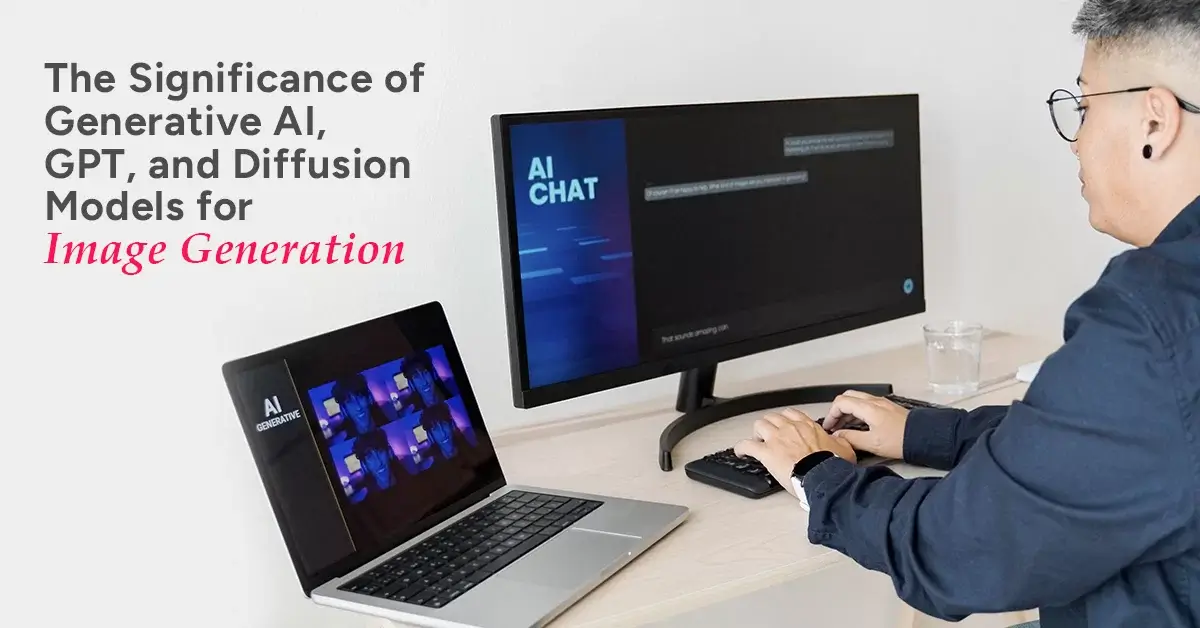Artificial Intelligence (AI) has made remarkable strides in recent years, with generative models emerging as a fascinating and versatile subset of AI. GPT (Generative Pre-trained Transformer) and diffusion models, have significantly impacted various fields, including image generation. Generative AI and diffusion models can be used independently and together. Therefore, these models are helping increase the efficiency and overall productivity of teams.
Some notable examples include:
VAEs: VAE’s are another popular approach to generative modeling for images. They can learn a probabilistic representation of images and generate new samples.
StyleGAN2: An improved version of StyleGAN that allows for the generation of high-resolution, realistic images with fine control over various image attributes.
DALL-E: DALL-E is a model that generates images from textual descriptions. It can create images of imaginative and novel concepts based on text inputs.
In this blog, we’ll explore the importance of generative AI, GPT, and diffusion models in the realm of image generation and understand how they are revolutionizing the way we create and manipulate images.
Creative Freedom
Generative AI models, including GPT, have democratized the world of image generation. These models allow artists, designers, and creators to break free from traditional constraints and generate images that were previously beyond imagination. Whether it’s generating fantastical creatures, dreamlike landscapes, or abstract art, generative AI empowers individuals to explore their creative potential without the need for extensive technical skills.
Augmented Creativity
Generative models like GPT can assist human creativity by providing a continuous stream of novel ideas and inspirations. By training on vast datasets, GPT can understand the context and style of an image and suggest new elements, compositions, or color palettes. This augmentation of human creativity has far-reaching implications, not only in art but also in fields like advertising, fashion, and entertainment, where fresh and innovative ideas are highly valued.
Automation and Efficiency
Image generation can be a time-consuming and resource-intensive task. Generative AI, especially diffusion models, have proven to be efficient in automating this process. These models can generate high-quality images quickly, saving valuable time and resources. This efficiency is beneficial in various applications, from generating training data for machine learning models to producing customized content for marketing campaigns.
Data Augmentation
In the field of machine learning, having diverse and abundant training data is crucial. Generative AI models can be used to augment datasets by generating additional images. This is particularly useful in scenarios where collecting real-world data is expensive or impractical. By leveraging GPT and diffusion models, researchers and data scientists can expand their datasets and improve the performance of their models.
Personalization and Customization
The ability of generative models to understand context and preferences makes them valuable tools for personalization and customization. For instance, businesses can use these models to create personalized product recommendations by generating images of products that align with individual preferences. This level of personalization can enhance user engagement and drive sales.
Art Restoration and Preservation
Generative AI has also found applications in the restoration and preservation of artworks and historical images. GPT and diffusion models can be trained to repair damaged or deteriorated images, reconstruct missing parts, and enhance image quality. This technology enables the conservation of cultural heritage and the restoration of priceless artworks.
Ethical Considerations
While generative AI has opened exciting possibilities, it also raises ethical concerns. The ease with which these models can generate deepfake images and videos has implications for privacy, security, and misinformation. It is essential to develop safeguards and regulations to mitigate these risks and ensure responsible use of generative AI.
Conclusion
Generative AI, GPT, and diffusion models are transforming image generation by providing creative freedom, augmenting human creativity, automating tasks, and enabling personalization. They have practical applications in various industries, from art and design to data science and marketing.
SkillGigs, an AI-based talent marketplace can help you get high-paying jobs with Generative AI skills. Some of the popular jobs on the platform include software engineer, data analyst among others. Sign up today to match with the jobs you want.





